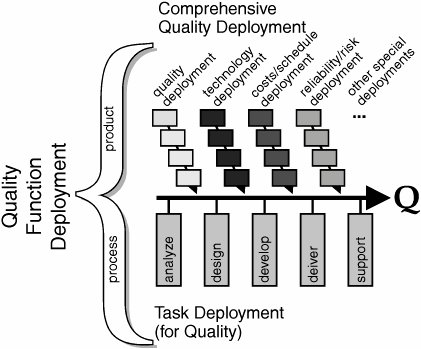Introduction
| QFD has been applied to software development for more than a decade, and its popularity is increasing. QFD as a comprehensive system for quality (see Figure 26.1) originated in Japan in the late 1960s and rapidly gained strength in the 1970s [Mizuno and Akao 1994, Akao 1992]. It spread to North America in the mid-1980s and to Europe in the late 1980s [Hauser and Clausing 1988, King 1989]. Software QFD began in Japan in 1982 [Aizawa 1982], in North America in 1988 [Zultner 1988], and in Europe in 1990. Today the use of QFD for software has spread to the point that most leading software organizations have tried it and are (at various rates) expanding their use of it [Zultner 1995]. But not all projects are successful. Figure 26.1. Comprehensive QFD is a powerful, mature quality system for efficiently delivering value in product development. Everyone applying QFD starts with just a small part. So what part of QFD should project managers start with? FailureSome software project teams have failed with QFD. They tried to do QFD based on a weak understanding of the method, or without understanding the differences between QFD for hardware and QFD for software. Encountering difficulties with no where to turn for assistance (or receiving ill-informed advice), they failedand blamed QFD for their own mistakes. Partial SuccessSome software project teams have succeeded with QFD only to stagnate and become a case of arrested development. These teams typically learned about the "House of Quality" matrix of QFD and applied it with success. Then they used QFD on further projects, but they did not apply it at the level that they were previously. Some software project teams are still doing "Kindergarten QFD" (they are only using the "House of Quality" matrix) five years after learning about QFD. However you get started with QFD, you want to progress toward a more comprehensive use of QFD so that you are getting all the benefits QFD has to offer [Nakui 1991]. QFD DefinedQFD is a quality system made up of subsystems, or deployments, each focused on one dimension of the development process (such as reliability). These deployments in turn are composed of a systematic series of tools, organized in a specific sequence to address the questions and concerns of that dimension throughout the project. (Refer to Figure 26.1 for Dr. Akao's graphical definition of QFD.) Comprehensive QFD is the term used to clearly indicate that the entire quality system is being referred to, not just one little matrix. Starting RightQFD has been undergoing continuous improvement and refinement, and signs are now visible of a "second-generation" QFD emerging in Japan, North America, and Europe. One example of this trend is Blitz QFD, a QFD method designed to be a better, faster, and cheaper initial QFD process than what many software project teams are currently doing. But not counter to those approaches, Blitz QFD was designed so that you don't have to break any bad habits to progress to a more sophisticated application of Comprehensive QFD. Let's first look at some of the problems software organizations have had with software development projects, and their causes. Then let's consider how Blitz QFD can help project managers better manage their product development projects. |
EAN: 2147483647
Pages: 394
